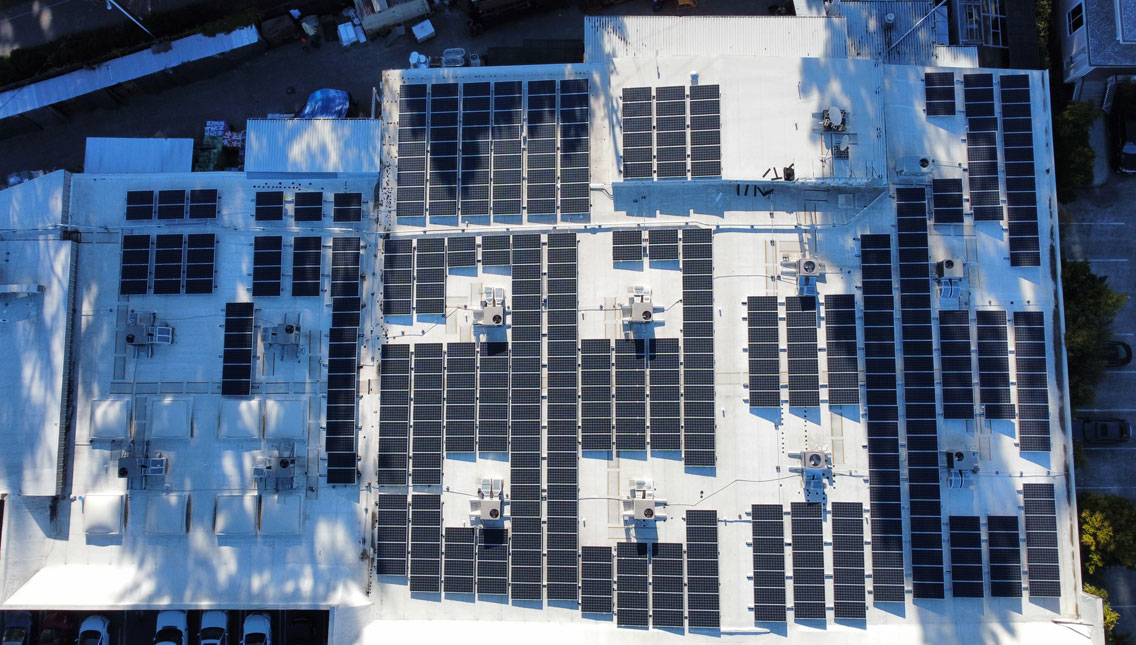Spreck Energy’s Residential Solutions
WE SPECIALIZE IN RESIDENTIAL SOLAR
No investment has a greater ROI than solar. Spreck Energy brings the power of the sun to your business, increasing your bottom line with an energy-stable future. Whether you’re looking to cut utility costs, find new sources of revenue, or demonstrate your commitment to the environment, Spreck Energy can help you do all of the above. From family-owned operations to corporate headquarters, businesses are discovering the practical benefits of going solar. Let us show you how an investment in solar energy can maximize the potential of your commercial property and earn you a profitable return.
How does
solar energy work?
Sunlight is absorbed into the cells of the solar panels. The electrons between the charged silicon layers of the cells become excited and produce DC electricity.
Excess electricity flows backward through the electric meter out to the grid. A “net meter” spins both forward and backward depending on whether you’re producing excess power or taking it from the utility company. In the daytime, the meter will either spin backward or slow the count forward.
You only pay for “net usage” — the difference between the amount you take from the utility company and the amount you give back. Depending on the size of your system and usage, the electricity you produce will cover either all or part of your overall electric bill.
This is a “grid-tied” system, which means that you are connected to the grid as both a producer and a user.
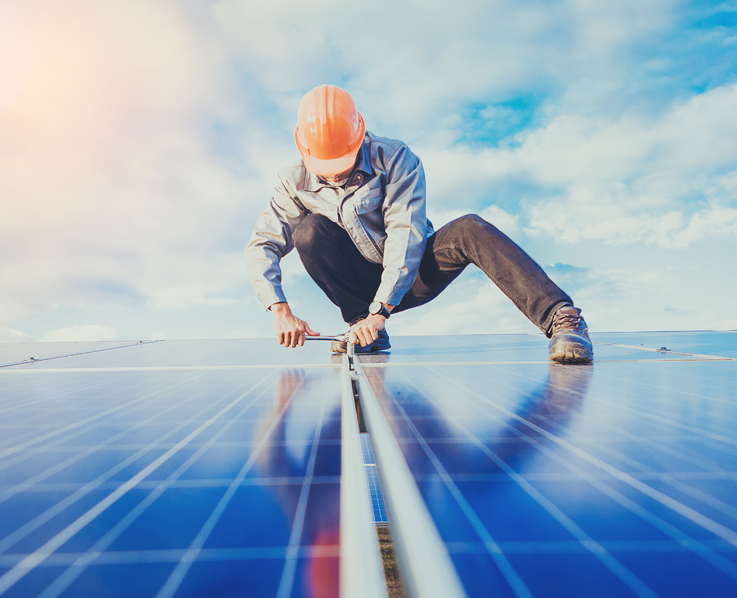
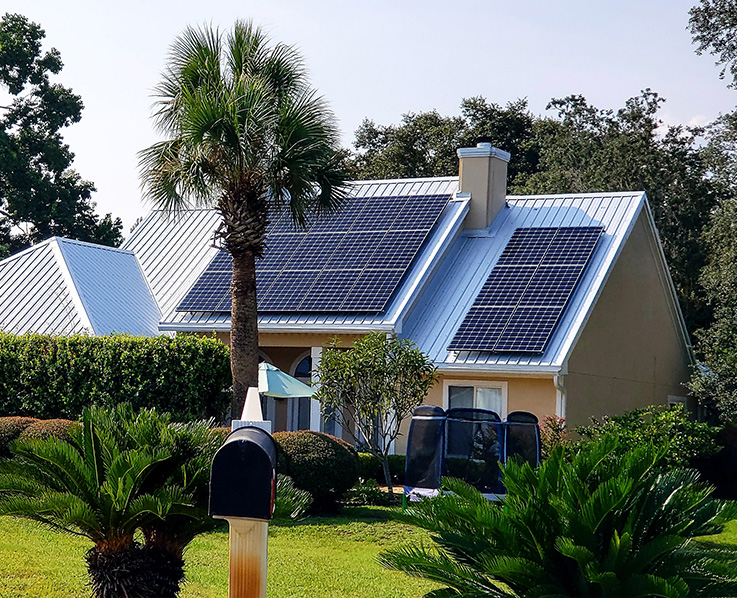
WILL SOLAR WORK
on my house?
To see if your house is a good candidate for solar, try out a solar panel suitability checker such as Google’s Project Sunroof. Then set up an appointment with our energy expert consultants who will visit your home to inspect its orientation (solar panels facing south capture more energy), roof angle and tree shading to see if your roof will receive enough sunlight to meet your family’s energy needs.
HOW MUCH DO
solar panels cost?
System costs vary depending on the size of your home (roof) and/or energy requirements. The total cost can also be paid in a number of ways, either financed through a home equity loan or with a system lease. Whichever way you choose to pay for your system, it will typically pay for itself in five to seven years and produce money-saving green electricity for years beyond.
Will I still have
an electric bill?
Yes — most home solar users will still receive a bill from your electric utility. Since your home and solar energy system will be connected to the electrical grid, the utility company will charge you a monthly connection fee — typically $14 to $17 per month. This is separate from the cost of electricity. However, the energy produced by your system will offset how much electricity you use from the utility and reduce the amount of your monthly electricity cost. In fact, during some months, your system may produce more electricity than you use and result in a credit on your electric bill. You will also accumulate credits on your electric bill for every month you produce more electricity than you use.
the 7 steps to going solar
We know going solar can be complicated. We are here as your expert guide every step of the way. With our customers, we are creating a planet run by the sun.

Energy Analysis
1

Site Survey
2
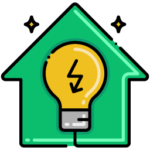
System Design
3
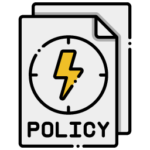
Permitting
4

Installation
5

Inspections
6

Utility Hookup
7
Frequently Asked Questions
In general conversation, photovoltaic is often used to refer to solar energy technology. Specifically, photovoltaic is the technology which uses silicon crystals and wire conductors to generate solar power. These crystals and wires are strung together into solar panels, which are then strung together to generate the desired amount of wattage. PV is the industry acronym.
The price of solar varies greatly from customer to customer. This is because the number of solar panels you need is directly related to how much power your family uses. Whatever your unique situation, going solar ensures that you will buy less power from the utility, which means a lower bill. When we provide a quote, we evaluate all the variables, including your family’s unique electrical usage, roof configuration, shading, and local utility pricing. We then customize a system to produce enough electricity to completely offset your usage, or partly offset your most expensive electricity during peak time.
Sizing a solar energy system requires much more than square footage alone. The number of solar panels needed is dictated by two main variables: how much energy you use, and how much money you want to save. In addition, energy use is entirely unique to each household, with variables such as the number of family members living in the home, time spent at work vs. at home, or temperature preferences all contributing to a very personal energy profile.
If you’re looking for something custom, we also offer fully engineered solutions that account for unique structural conditions, additional components such as batteries and EV chargers, as well as custom equipment locations and aesthetic requests. From there, we develop a detailed site plan and savings proposal that is totally unique to your home and family.
No, unless you have a fully off-grid system, your solar panels are integrated with the utility grid and will not operate if the grid is down.
Your system will function on cloudy days, but it will produce less electricity depending on the density and duration of the cloud cover.
This is one of the most common myths that hold homeowners back from investing in solar energy. As for performance, engineers have improved efficiency of the modern solar cell to the point where future advancements are likely to be mostly incremental.
Right now there are very lucrative federal tax incentives available that are scheduled to decrease in the coming years. Overlay this with the fact that local utilities are working to increase their grid access fees for new solar customers and the question really becomes: how much money do you stand to lose while waiting for small changes in efficiency and price?
When you’re producing more electricity than you’re using, the utility’s electric meter spins “backward” because you’re feeding your excess energy back into the grid.
Utility companies will credit you for every kilowatt hour you produce more power than you use. Conversely, when you need more power than your solar system is producing, such as at night or on cloudy days, you can cash in your energy credits and avoid purchasing that needed power directly.
Thanks to net metering, at the end of each month, you’re credited or charged for the difference between what you produce and what you use. At the end of each year, depending on your utility company, you may receive either a check or a credit for any extra credits still remaining on your account.
Different utilities have different net metering policies, fiscal periods, and payback plans.
We recommend yearly cleanings to keep your panels, dust and debris-free and operating at peak efficiency. Every once in a while, such as after a really bad dust storm, you may need to augment that yearly cleaning schedule. It is also important to inspect your panels for bird infestations. Occasionally, birds will nest in the shaded area under the array. This can cause problems with proper water shedding which can, in turn, damage roof underlayment.




